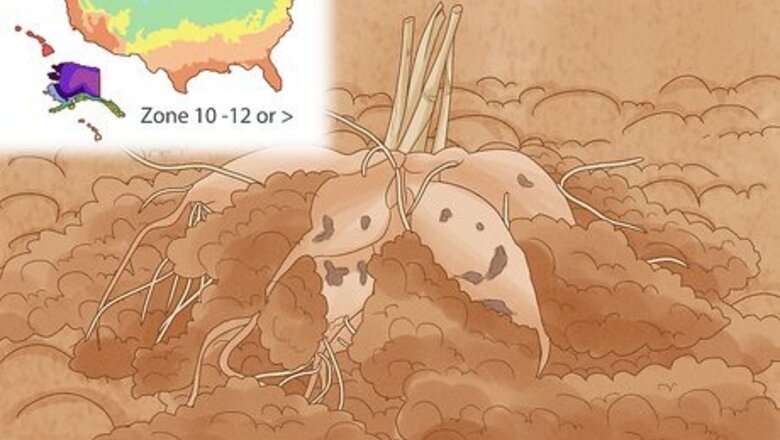
views
Remove the bulbs after the first hard frost.
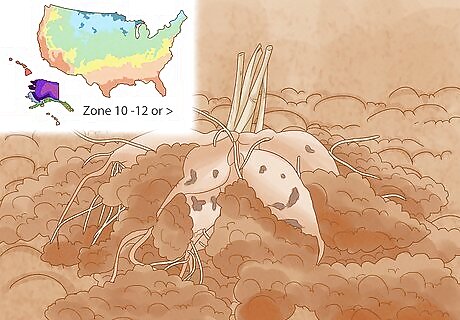
Waiting until the cold season ensures the bulbs can store energy. If you dig the bulbs up right after they finish blooming, they will not have matured enough and won't have the energy they need for the next season. Instead, wait until after the first hard frost or until the foliage dies. The first hard frost can range from August to October. If you live in a climate where the ground doesn't freeze, you don't need to dig up the dahlia bulbs at all.
Cut the stems 6 inches (15 cm) high.

Get rid of the foliage, so it's easier to handle the clumps of dahlia tubers. Wait to cut the flower stems until you're ready to dig up the tubers—this way water doesn't collect in the hollow stems and cause the plant to rot. Then, take a pair of sterilized shears and clip the stems, so they're around 6 inches (15 cm) from the ground. To sterilize your garden shears, dip them in a bleach solution of 1 part bleach to 10 parts water. It's important to wait until the foliage dies since the tubers will keep developing until this happens. You'll have more success storing and planting mature dahlia tubers.
Dig up the tubers with a pitchfork.
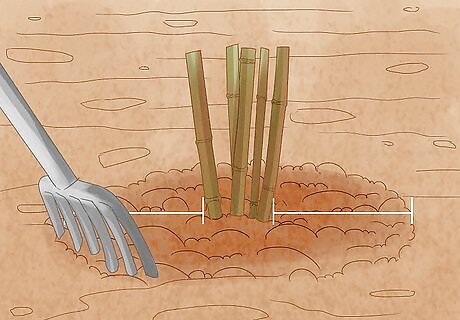
If you dig a large hole around the dahlias, you’ll avoid injuring the roots. Since you don't want to stab or damage the bulbs, use a pitchfork instead of a shovel—it's less likely to dig into the tubers and damage them. Push your pitchfork into the soil a few inches away from the dahlia plant and work in a circle to loosen the soil. Then, insert the pitchfork and lift the clump of dahlia bulbs up. Use wiggling motions to break up the soil. This can make it easier to locate the dahlia tubers without accidentally cutting into them. Avoid pulling the clump of dahlias out of the ground by the stem or you could damage the tubers.
Shake the soil loose from the tubers.
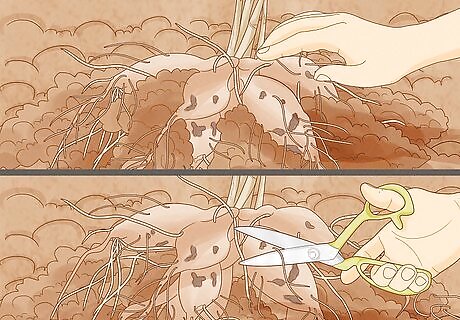
Soil contains potential pathogens, so remove it before storing the bulbs. Brush the tubers with your hands to encourage clumps of soil to fall off. If the tubers have lots of thin, hairy roots growing off of them, trim them off with sterilized scissors. Pop on a pair of gloves if you don't like to get your hands dirty. Set aside the tuber while you finish brushing the soil from the remaining bulbs.
Rinse the dahlia bulbs with a garden hose.
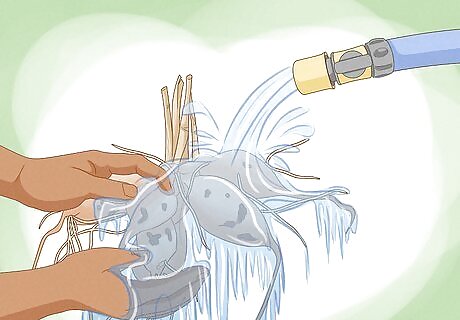
Remove most of the dirt from the tubers before you store them. The dahlias will be less likely to rot if you remove soil and its pathogens right after you dig them up. Hold the tubers under the garden hose and rinse off the soil with cool water. Take care not to scrape or puncture the dahlia's skin while you clean. If you're rinsing a lot of dahlia bulbs, set a screen of hardware cloth or mesh on top of a big empty garbage can. Place the tubers on the hardware cloth and hose them down. The water and soil collect in the garbage can, so you can simply pour them back into your garden when you're done. If you don't have a big garbage can, fill a small tub or basin with water in order to wash the bulbs.
Dry the tubers for 1 to 3 days.

Cure the tubers in a warm room before you pack them for winter storage. Spread the cleaned dahlia bulbs on a tray and put them in a room where they won't be exposed to direct sunlight or wind. They'll cure best when the temperature in the room is between 60 to 70 °F (16 to 21 °C). While you can cure the dahlia bulbs in the garage, don't place them directly on the garage floor because it can pull too much moisture out of the bulbs. Don't wait more than 3 days to pack your dahlias because they could dry out too much and shrivel up.
Inspect the tubers before storing.
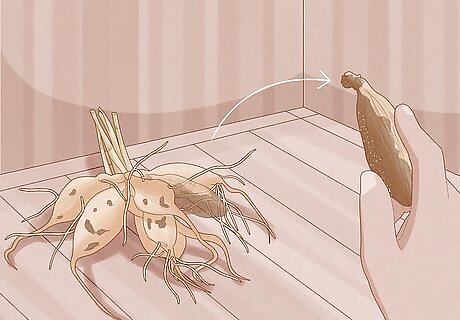
Discard insect-infested or rotten tubers. Look through the cured tubers and throw out any that have insect damage or feel squishy or mushy. If you pack healthy tubers in with a diseased one, the virus can spread to the good dahlia bulbs. If you live in a very wet or humid climate and are worried that the dahlia bulbs could rot while in storage, dust the tubers with a plant fungicide powder before you pack them. If you notice there are several tubers growing together, you can use sterilized garden shears to cut the tubers apart.
Choose a storage container for the bulbs.

Dahlia bulbs need good ventilation, so they won't shrivel up. Pick a container that's large enough to hold all of your tubers. You probably have great container options lying around your home. Consider using: A cardboard box: This option is inexpensive and easy to find. A wooden box with ventilation holes: Your wooden box can be used to store dahlias for several seasons. A plastic bag: A plastic bag is an inexpensive option and it doesn't take up much space. A styrofoam container: This option is lightweight and stackable, too. Note: Storing dahlias in the refrigerator isn't a valid option. This can remove too much moisture and cause the bulbs to shrivel.
Pack the tubers between dry storage material.
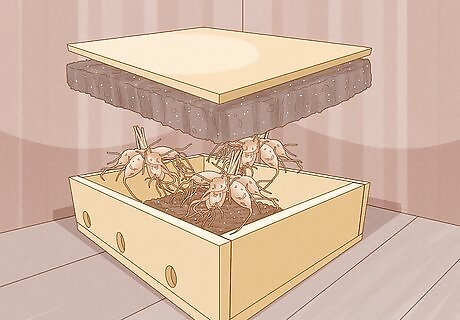
Layer the cured bulbs between peat moss, sawdust, or potting mix. Spread 2 to 3 in (5.1 to 7.6 cm) of dry storage material in the bottom of the container before you put the dahlia tubers in. Ensure that the tubers aren't touching each other. Then, spread another few inches of material over the dahlias. Repeat these layers until you've packed all of your tubers. You can also use dry compost, sand, vermiculite, or coir—shredded coconut husk fiber. Shop for these at your local hardware store, garden center, or online. If you'd like to label the individual dahlia tubers, write the variety on each tuber with a permanent market before you pack it in the container.
Label the packages of dahlias.
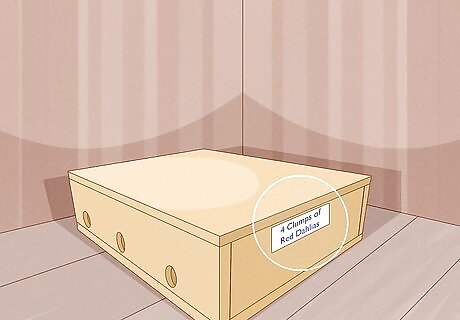
Write the variety type on the container, so the package is easy to find later. You might think you'll be able to remember exactly what's in your gardening box, but labeling is always a good idea. Write down roughly how many tubers are inside and what variety they are. If you're not sure what variety of dahlia you're storing, write any identifying characteristics you can think of. For instance, write, "4 clumps of red dahlias—from the side yard."
Store the packed tubers over the winter.
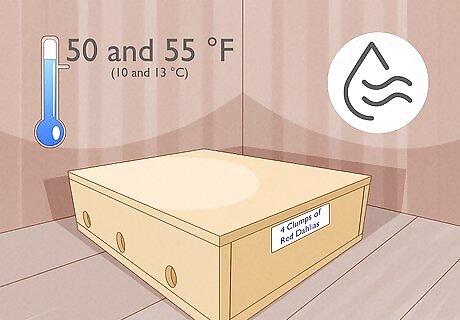
Keep the dahlia containers in a cool, dry, and dark location. Choose a storage spot with temperatures between 50 and 55 °F (10 and 13 °C)—avoid temperatures below 45 °F (7 °C) or above 70 °F (21 °C). A dry basement, cellar, garage, or shed is a great place to store dahlia bulbs over the winter. If you live in a temperate climate, you could keep the container of dahlia bulbs outside as long as they have shelter and air circulation.
Check on your bulbs throughout winter.
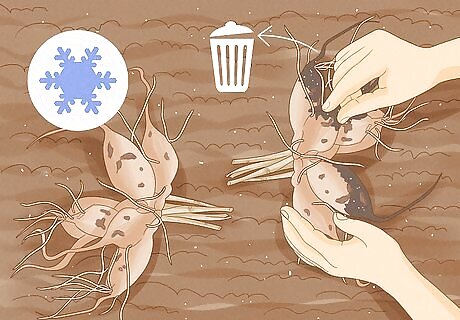
Inspect the bulbs once a month and discard rotten tubers. If you leave a rotting tuber in the container, it could spread to other dahlia bulbs. While you're looking at the tubers, check the moisture level. If any tubers look like they're shriveling, mist them lightly with water. If the packing material feels very moist (like water is condensing and getting trapped), keep the lid off of the container or leave the bag completely open, so the material dries out a little. Wait until the weather warms up in the spring before you grow your dahlia bulbs.


















Comments
0 comment